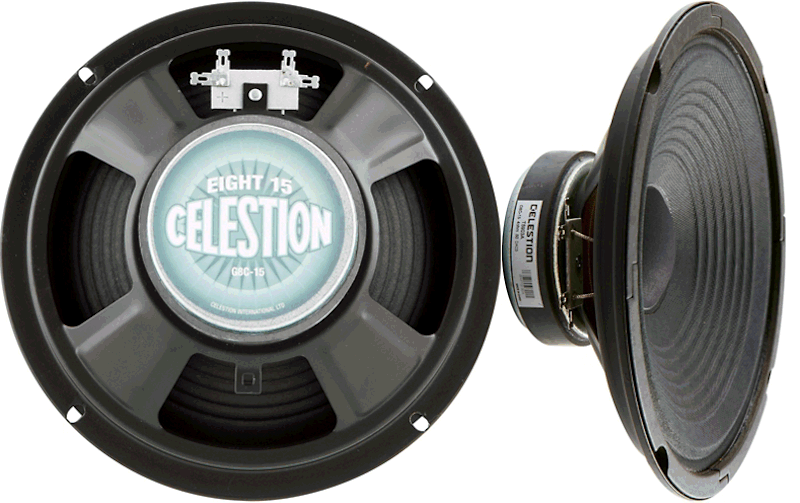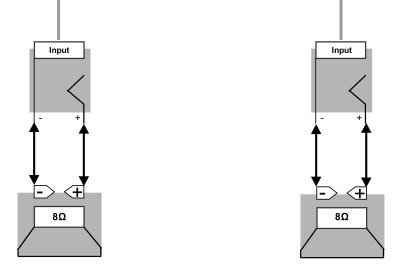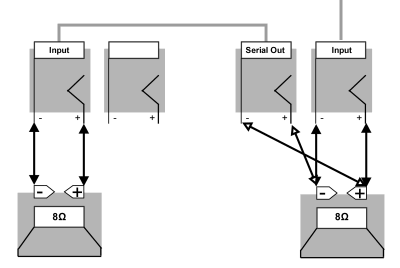|
|
This article demonstrates how to easily and cheaply modify a guitar cabinet so that two or more cabinets can be run in parallel or serial. This article is primarily for amplifier enthusiasts, electronic hobbyists, and do-it-yourselfers who like making things. You should have basic soldering and electric tool skills.
On the right is Orange Amplifiers PPC108 Micro Dark 1 x 8" guitar speaker cabinet. It has a 1 x 8" "Voice of the World" speaker driver and sounds pretty good for its $100 retail price. However, what caught my eye is how sturdily it was built with tolex covering, metal corner caps, lay-flat handle, and cane grille. So, after pulling off the cheap, hot-glued plastic logo, I am now ready for modding.
|
|
Pressed board is dense, but it is susceptible to water. So if the cabinet is played in the rain. or gets soaked in a flood, the boards are probably going to fall apart.
Pressed board does not take screws well and repeated disassembly will probably tear apart the screw holes. Using glue will repair the holes, but it will make the next disassembly a problem.
 |
Speaker sizes seem to be miniaturizing lately. In the old days, most home speakers had at least one 8" woofer. If you had more money, you bought one with a 10 or 12" woofer or more drivers. This was considered ample low bass for most home listening.
Then came the home theater era of the 1990s, and many people bought speaker cabinets with 6" and 4" woofers. Few seemed to care about bass. Those who did bought a single-driver 12" sub-woofer.
Nowadays people buy Bluetooth-enabled speakers, and they think they have great bass on their 4" speaker. Perhaps compared to the phone 1/4" piezo-driver they are correct.
If you are a guitarist like me, a 12" driver is great, and bigger or more is preferable. It sounds strange to consider an 8" cabinet as a lightweight portable cabinet when it dwarves most people's home sound system these days.
 |
Ideally, your guitar amp has two output speaker jacks, and then you can play them both as shown in the schematic diagram. One output goes to the left speaker cabinet input jack and drives the left speaker. The other output goes to the right speaker cabinet input jack and drives the right speaker.
In the diagram two eight ohm (8Ω) speakers are shown. Eight ohms is the impedance of the driver, and this is a very common load value for guitar amps. One terminal of the driver is connected to the center (positive) connecter of the input jack. The other terminal of the driver is connected to the ring (negative) connector of the input jack.
However, many smaller guitar amplifiers usually have a single output jack. The rest of the article shows you how to hook up one speaker output to two speakers inputs with an extra jack ($5), some wire, and a soldering iron.
 |
An issue known as Ohm's Law comes into play with two speakers wired in parallel. The impedance of two 8 ohm speakers in parallel is halved to 4 ohms. This may cause an issue with your guitar amp output. You must use this 4 ohm parallel combo with an amp output of 4 ohms. If you don't, you risk burning out your amp transformers and circuits. Or you may start with two 16 ohm speakers to create an 8 ohm parallel combo. Many smaller amps are more likely to have three 4, 8, 16 ohm outputs than a second 8 ohm output. So hopefully this cabinet modification gives you an option.
 |
Ohm's Law also states that the impedance of two 8 ohm speakers in serial is doubled to 16 ohms. You must use a 16 ohm serial combo with an amp output of 16 ohms. Or you may start with two 4 ohm speakers to create an 8 ohm serial combo. In my case, I started with two 4 ohm speakers, so I used this option to hook up to a single guitar amp 8 ohm output.
|
|
The photo shows the single speaker input jack for the Orange Micro Dark cabinet. The original speaker was a very common 8 ohm driver. To use the same 8 ohm amplifier output, two speakers must either be two 16 ohm speakers in parallel, or two 4 ohm speakers in serial configuration.
|
|
Orange could have saved money if they used a typical mono jack connector. The Orange connector is a stereo jack which has left, right, and ground connections. Notice the jack in the picture has six legs, 3 for internal ground/left/right and 3 for external ground/left/right. Also notice, the middle connector is unconnected. The good designers at RCA made the stereo jack backwards-compatible, so you could use the newer stereo connector. The stereo jack costs a little more because it has more pins and connections. This connector also has another feature that plays into this story.
|
|
Here I have used my drilling skills to add a second jack next to the original jack. I used an inexpensive mono jack which has a single ring (ground) and a center (positive) connection. I soldered a black wire to connecter ground and a red wire to the connector positive.
|
|
Can you see the problem with this wiring?
The issue is NOT that my black wire routes to the speaker connector red wire. Recall, this is a serial configuration, and we have to reverse the wires to get the speakers to add their loads. (See the schematic above if this does not make sense.)
Here is a clue to the issue. Notice that there are three tiny metal tabs shown on edge in the center of the photo. These tabs are touching the the 3 legs closest to you, forming a nice connection.
|
|
The problem with this wiring stems from the fact that the original input jack is not a typical mono speaker jack, but rather a stereo guitar input jack. Orange somehow must have scored a deal on these jacks because they are not often used for speaker jacks. They are most often used for guitar inputs. For guitar input jacks, the idea is that when the input cable is removed, the guitar inputs are connected to ground, removing it from from the amplifier circuit. This makes the amp input more immune to noise and makes the guitar amp quieter.
|
|
Notice that both the speaker terminal wires and the new output connector wires are connected at the same point, always making good contact.
Again the reason why the red jack wire connects to black speaker wire is to flip the polarity of the connection, thus putting two speakers into a serial configuration. If you are building a parallel configuration, you would wire red to red and black to black.
|
|
Here is one way to validate your speaker wiring. Whether you have a parallel or serial configuration, given the same input, two eight inch drivers should be twice as loud as a single eight inch driver. If this is not the case, you probably have wired the combo incorrectly.
On my system, I noticed that a single 4 ohm speaker in the amp 4 ohm output was louder than two serial 4 ohm speakers in the amp 8 ohm output. I had one speaker driver connected in reverse to the jack plate, and so the two speakers were canceling each other's sound output. I reversed one speaker wiring, and sure enough, two speakers are twice as loud as a single speaker.
|
|
On the extreme left is a single 15" driver speaker cabinet. You can see that the two eights stacked are about one inch taller than the fifteen.
On top sits a lightweight Quilter 101 mini amp head. In combination this makes a very light and powerful traveling guitar combo.
Thanks for visiting the site and reading the article. I hope you enjoyed the detailed photos and commentary. Feel free to email me with any comments or questions. More articles are found at the parent Guitars and Music page.